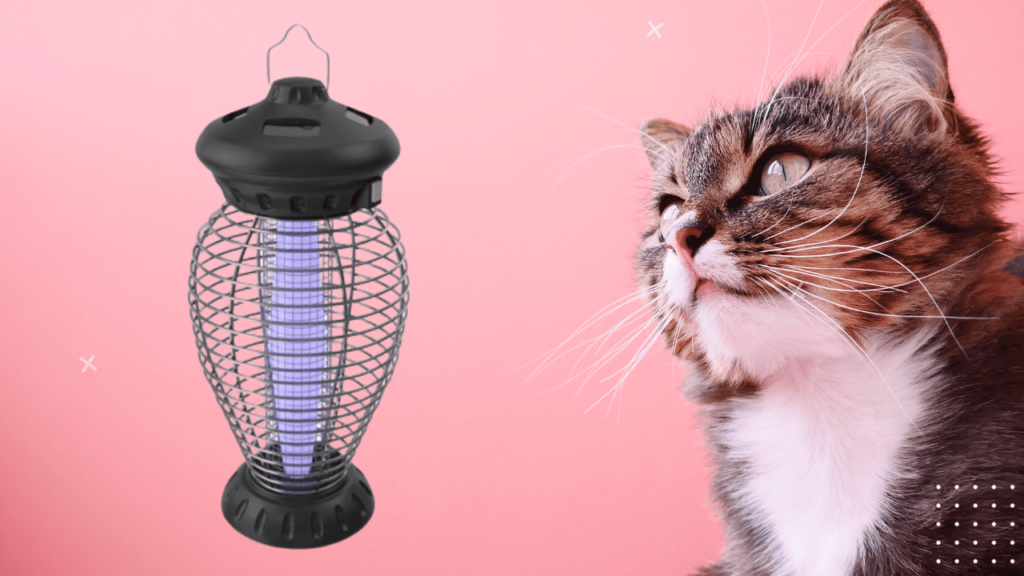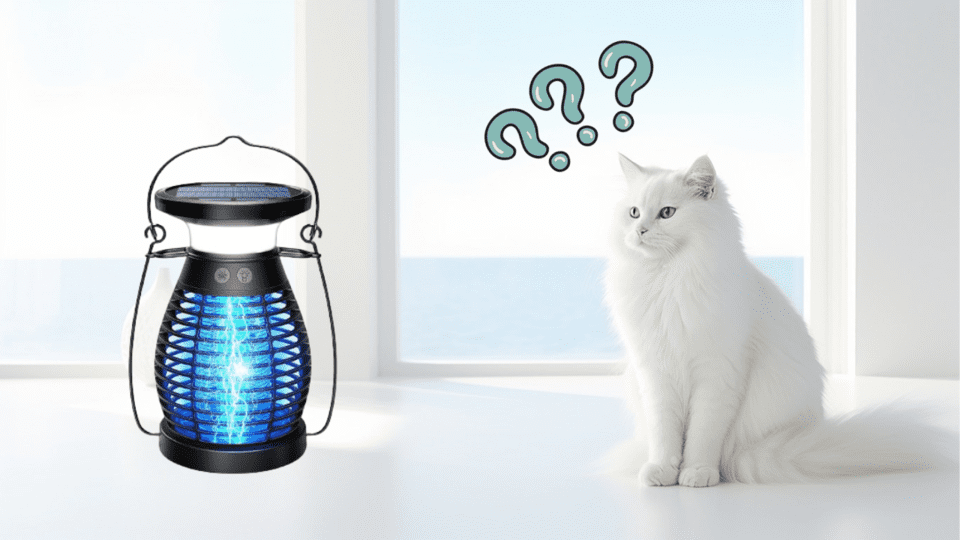


Summer evening barbecues with family and friends can be so enjoyable. The laughter, joy and connection make memories to cherish. Yet often uninvited guests arrive – mosquitoes buzzing, moths fluttering around the lights. Bug zappers promise relief, eliminating these pests with swift electric zaps.
But what risks do they pose for our curious kitties who may bat at these intriguing devices? Let’s explore the truth.
Bug zappers utilize ultraviolet light, heat and electric grids to lure then electrocute unsuspecting insects. This effectiveness, however, raises safety concerns for pet owners. Could accidental contact injure or kill a cat?
Thankfully, bug zappers are designed with protective features making serious harm unlikely. The internal grids carrying 2000-4000 volts are small and shielded by plastic barriers. Still, any amount of contact risks burns or trauma. So proper precautions are essential, especially knowing our furry friends’ curiosity!
Two key factors determine if bug zappers pose dangers for curious cats – the intensity of electrical contact and grid cover design.
While household outlets deliver 120-240 volts, bug zappers supply a heftier 2000-4000 volts. This sounds alarming! But another measure – amperage – indicates shock risk more accurately. Standard outlets provide 15-20 amps, while most bug zappers only emit under 0.5 milliamps. With such low current flow, brief contact causes discomfort, not lethal harm.
Still, longer contact duration or location (eyes, mouth, heart region) escalates risk significantly. Kittens and small cats are also more vulnerable to trauma. So preventing any interaction is crucial.
Thankfully, safety-minded designs minimize access to electrified grids inside. The small zinc or copper grids are encased by protective plastic or wire cages. Openings are narrow enough to zap flies and moths while excluding curious fingers and paws.
Some models feature cut-off switches that break the circuit if touched unexpectedly. Opting for these thoughtfully engineered products reduces risks. But supervision is still advised.
While safer designs help, proactive measures to avoid mishaps are essential.

Strategic placement is key. Position bug zappers at least 5 feet off the ground, attached securely to walls or posts. Ensure cords are fully covered and chew-resistant. Dangling cords tempt playful pawing and chewing.
During use, check frequently that curious kitties are maintaining a safe distance. Redirect their attention if drawn too near. And ensure good outdoor lighting so they avoid blundering into an unseen wall-mounted trap.
Another concern – cats snacking on electrocuted insects around the device. Bug zapper manufacturers warn against emptying catch trays onto the ground for this reason.
Ingesting toxins or pathogens from these dead insects poses internal risks. Plus the tempting “treats” may encourage cats to investigate the source. So prompt removal and sealed disposal is best.
Initially believed to control mosquito populations, new evidence shows bug zappers may unintentionally do more harm than good.
While effectively eliminating some biting insects, bug zappers also kill beneficial species like pollinators and pest predators. This disrupts local ecosystems and food chains.
They also emit carbon dioxide attracting mosquitoes and other hungry insects from wider surroundings. So more bugs may converge than are eliminated!
Finally, the influx of dead insects and concentrated carbon dioxide draws in opportunistic predators – bats, spiders and insect-eating birds circling a likely feeding ground. Their sheer numbers and droppings can become a secondary nuisance!
So the intended pest control gets further compromised. Rethinking their use is prudent.
If using bug zapping devices, responsible steps ensure safety.
Carefully read all instructions before positioning and switching them on. Review safety information, troubleshooting tips and maintenance procedures. Improper use compromises your pets’ wellbeing and product effectiveness.
Mount securely out of pets’ reach on stable walls/posts at recommended heights. Ensure electrical cords are fully covered by tamper-proof conduits.
Check devices before first use each season. Ensure protective grills/cages aren’t bent or damaged after weathering/use. Clear any debris obstructing light beams or limiting insect contact with grids. Proactively replacing bulbs, cleaning and removing catch tray contents prevents problems.
Thankfully many effective options allow enjoyable outdoor living without risky zappers.
Strategically placing natural insect-repelling plants like lavender, mint, basil and rosemary deters mosquitoes. Position them near seating areas, play spaces, kennels and coops.
Citronella’s clean, lemony aroma also repels insects when concentrated in candles, torches or scented oils. Create relaxing, pest-free areas people and pets can enjoy.
Mosquito netting over patios, animal housing and people-spaces provides breathable protection. Drape netting tent-style, or install wire-framed screened enclosures. Properly installed, nets are safe, eco-friendly and extremely effective!
Luring biting insects into containment devices controls populations without disruptive zapping. Propane-powered mosquito traps mimic human presence through warmth and exhaled carbon dioxide. Add a fan and voilà – mosquitoes get sucked straight into attached nets or catch bags!
Sticky traps loaded with pheromones or ultraviolet light also snare tons of aphids, thrips and fungus gnats seeking love connections! Place these discreet controls in areas pets can’t access.

Inviting insect-feasting birds, bats, and beneficial insects promotes natural control without risks. Place birdhouses and bat boxes in trees near standing water, gardens and compost piles – prime mosquito habitat. Their occupancy ensures continual, chemical-free bug elimination! ladybug on leave
Ground beetles, ants, ladybugs and green lacewings are purchased or attracted through habitat adjustments gobble aphids and other garden pests. Once established, they stick around keeping crops lush and pest-free.
Good sanitation and maintenance establish permanent pest barriers. Regularly clear standing water, trim vegetation and eliminate food waste where mosquitoes and flies breed. Tend gardens gently keeping beneficial insects and microbes intact. Such common-sense nurturing supports a balanced ecosystem with minimal interventions needed.
Caring pet parents simply want enjoyment and safety for all family members – both furry and human. While bug zappers carry minimal risks when used properly, assessing their pros and cons is wise. Alternative insect controls provide comparable benefits without concerns. Attentive maintenance establishes a healthy habitat with minimal required interventions.
Ultimately, the most powerful protections come through education, evaluation of all impacts, and then choosing approaches aligning with our values and priorities. With these insights, we can savor relaxing summer moments without unwanted biting guests – both the insect and electric zapping kind!
Can my cat get injured by a bug zapper?
It’s unlikely but possible. Bug zappers are designed to be safe around pets with protective barriers and low amperage. But any contact with the electrified grid risks burns or trauma. Keep zappers out of reach and supervise cats nearby to be safe.
How can I keep my cat away from the bug zapper?
Mount the zapper at least 5 feet high on a stable surface so it’s unreachable. Ensure cords are fully covered and chew proof. Position it away from sleeping/feeding areas and occupy your cat’s attention if they get fixated on the device.
Why shouldn’t I let my cat eat the dead bugs around the zapper?
Ingesting zapped insects poses health risks to cats. The bugs could contain toxins, bacteria or have eaten pesticides beforehand. Consuming them may cause gastrointestinal issues. Promptly clean around the zapper to remove any tempting insect carcasses.
What are some cat-safe alternatives to bug zappers?
Consider citronella candles, essential oil insect repellents, protective netting/screening, propane powered insect traps, pheromone sticky traps or introducing natural predators like birds, bats and beneficial insects to control bugs safely and effectively.
How often should I maintain the bug zapper for safety?
Check it over before first using it each season. Ensure protective barriers are intact, light fixtures work properly and the catch tray is emptied. Wipe down the exterior and interior killing grid to remove dirt, grime or insect remnants that could impede functioning. Replace bulbs as needed.